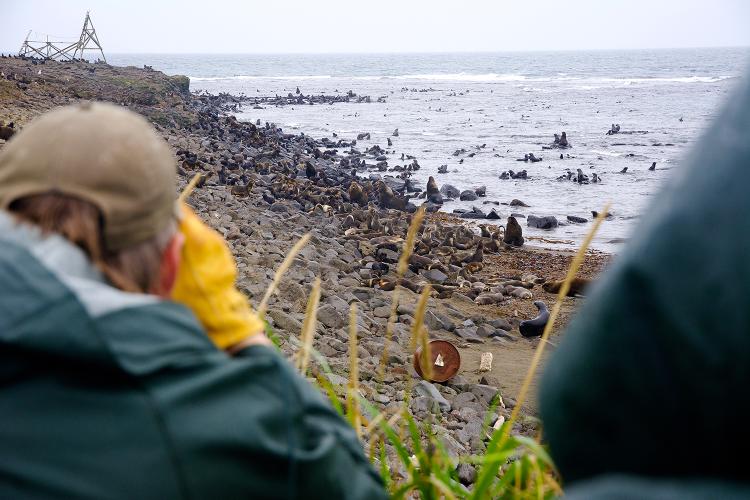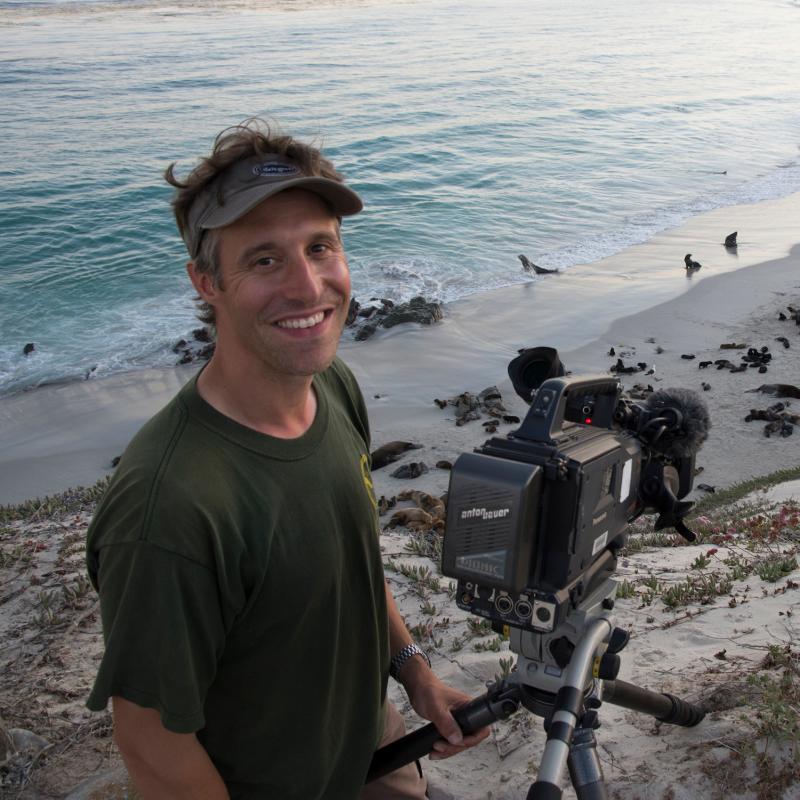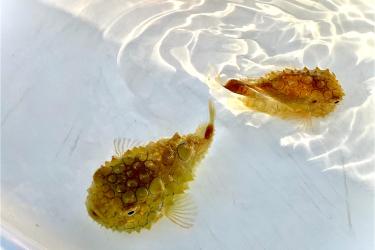Fur Seal Science: Week 2
During our second week of northern fur seal research on St. Paul Island, our crew turned to several different missions. Here’s a synopsis of each.
Mark-Recapture Sampling
As a follow-up to pup shearing, Rolf and Rod returned to each of the five rookeries where we marked pups to determine a ratio of marked to unmarked pups. Unless a rookery offers natural topography that allows looking down on the animals, this is an extremely difficult task. Years ago, biologists built tripods and catwalks to provide safe access to the rookeries. These structures can provide great perspectives for pup sampling too.
Once in position, they sample the population by counting groups of 25 pups and tally the number that are marked. This sampling process is repeated across the entire rookery, with each count representing unique groups of pups. Between the two of them, Rod and Rolf will sample each rookery twice and end up with more than 1,000 individual samples. Once all the data is compiled and analyzed, they will have a ratio of marked pups calculated from the sampling process at these rookeries. With this sampling ratio, and knowing the number of pups that were initially marked, they will then calculate an estimate of the number of live pups at these five rookeries (Morjovi, Polovina, Reef, Zapadni Reef, and Zapadni).
In a normal year, when all 19 rookeries on St. Paul and St. George are sampled, there are typically between 3,000 and 4,000 samples collected. These additional data help to refine the estimate for the total number of pups on the Pribilof Islands. This year, Rod (our statistician) will use the data from the five rookeries sampled and, together with data from the dead-pup counts (see below), extrapolate an estimate for the total pup production in 2021. Results will be available by the end of the year. Next summer, we plan to have a full crew out here to get back on track with the full survey.
Dead Pup Counts & Diet Sampling (Poop Collections)
The terrain where northern fur seals breed is rough and unforgiving. This, along with the high density of animals, including aggressive and highly territorial adult males, contributes to pup mortality. An estimate of total pup production would be incomplete without taking this natural mortality into account. So, to complement the mark-recapture sampling of live pups, another crew performs a comprehensive scan of the rookery to count the total number of dead pups. To avoid counting the same pup twice, the team marks a counted pup with a sprinkle of light-colored kitty litter. Among the five rookeries, we counted 1,249 dead pups.
While on the rookery, another member of the team collects fecal samples, aka scat. Molly is trying to find medium-sized poops from adult female fur seals. In between nursing events, these females are coming and going on foraging trips that last between a couple days to over a week. We analyze seal scat to understand what they are eating. This is important information that contributes to effective conservation of the fur seals, and the specific prey species that they depend on.
Pup Weights
Another important statistic that we collected is pup weights. This metric helps us understand the relative condition of pups over time. With oceanographic anomalies like the 2014 warm blob in the North Pacific Ocean, and a follow-up marine heat wave in 2019, long-term trends of pup weights can give scientists insight on how they are faring under changing climatic conditions. They can also tell us about the abundance of different prey populations.
At each of four predetermined rookeries, we weigh at least 250 pups as quickly as we can. Our goal is to minimize stress and disturbance on the animals. We round up a group of pups and contain them using portable fence sections. Pups are then picked up one at a time to determine their gender and to place a temporary mark on their flippers with a cattle marker (essentially a large yellow crayon). Then we carefully place them into a cone, which helps to secure the pups when the cones are hung from scales on portable tripods. After recording the gender and weight of each pup into the data book, the pups are released back into the rookery. The flipper mark ensures we don’t weigh the same pup twice.
This year, we weighed 1,023 pups with a total weight more than 18,000 pounds! Typically, male pups are heavier than females. In this year’s sample, male pups averaged about 19 pounds, compared to females at closer to 16 pounds.
VHF Tag Monitoring and Flipper Tag Re-Sights
Tagging fur seals before they leave in November for their winter migrations is another method to understand the survival, reproduction, and behavior of individual fur seals throughout their lifetime. We are also able to compare these trends between populations of fur seals at different breeding areas.
In late September, crews will tag pups and adult females at three rookeries on St. Paul and St. George Islands with small plastic flipper tags (each with a unique identifiable number). Throughout the summer, biologists conduct regular sighting surveys at these three rookeries to record the presence of tagged fur seals. Some adult females will also be tagged with a VHF radio attached to one of the flipper tags. A network of receiver stations was set up for the first time this year in collaboration with NOAA Fisheries’ Alaska Regional Office and the Tribal Government of St. Paul Island. It will offer a passive method for tracking fur seal movements to other rookeries (where sighting surveys are not occurring). We will also examine the attendance cycles of these adult females, such as nursing and foraging trip durations.
Fur seals have strong site fidelity, meaning that as adults, they will frequently return to the same stretch of beach year after year. However, as we are finding, this is not always the case.
See the final blog in this series (Blog #5) to learn more about the specific rookeries on St. Paul, to understand more about why certain sites were selected for this year’s sampling, and finally why some animals could be emigrating to other rookeries or islands.














